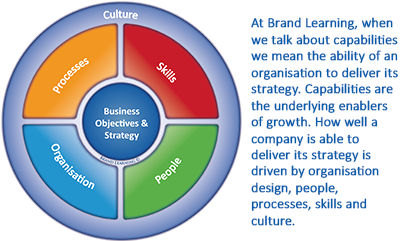It’s obvious to us that the best route to sustained growth is by motivating more customers to spend more with your company. Mergers & acquisitions and improving operational efficiency can also deliver growth, but are inevitably limited over time – so sustained growth requires selling more products and services to customers: by creating superior customer value.
The trick comes in how you manage it. Do you offer people the most technically amazing products and services in the market? Do you tailor your products for the needs of your intermediaries to create strong routes to market? Do you drive operational efficiency to delight customers with reliability, speed and price? Do you innovate to tap into emerging customer behaviours? The priorities will differ depending on where you sit in the organisation. I’m sure you can pick out the different leanings of technical, operations, finance, sales and marketing teams. And all could argue they are customer-centred.
In the digital age, where the customer experience is increasingly omnichannel, transparent, shared and empowered; where customer behaviours have changed and at the same time most industries face increasing competitive intensity; creating value for customers requires organisation-wide consistency, and new, joined-up capabilities.
We call this uniting around a connected customer agenda. Here, different teams define a common vision for the customer experience, and work together as a customer experience engine to deliver it.
This is not the same as creating cosy consensus between teams where all decisions are straight-forward because everybody agrees. It is about harnessing natural tensions to create something stronger: a vision rooted in the end-customer and made deliverable by explicit consideration of the implications across the value-chain, creating shared goals and a transparent plan.
For example, the CMO of Frito-Lay, as part of The Boardroom Project, re-organised the Marketing Leadership Team to become a Growth Leadership Team (GLT) made up of the heads of marketing, and also the leaders of finance, insights, operations, legal, HR and sales. Several other leadership teams were also subsumed by this GLT, creating joined-up analysis of performance, budget decisions and accountability. Did it mean that different teams all took a marketing perspective? No. But it did create mutual understanding, collaboration and stronger decision-making that made implementation easier.
So how in practice can companies build joined-up capabilities?

Let’s pick out some examples of how this translates to creating a connected customer agenda:
1. Joined-up Strategy
One study reports organisations with tightly-aligned sales and marketing have 36% higher customer retention rates and 38% higher sales win rates. It is valuable to get customer-facing plans connected, but it’s not easy. Often it goes wrong at the first hurdle: agreeing a common set of goals and metrics with aligned views of customers and segments. And that’s before the debates kick in about forecasting, budget allocation and priorities. Sales and marketing need to find better ways to join up their plans. In FMCG companies this means developing a clear view of the desired consumer experience across portfolio, category, brand, channel and customer plans. In Pharmaceuticals therapy areas or franchise structures enable teams to take a similar approach. We’ll talk about this topic in more detail in our forthcoming strategy and planning post.
2. Organisation and People
The Frito-Lay GLT is one example of organising for connection, however it’s not just about cross-functional teams. Companies need to ensure their operating model, the organising principles for who does what in an organisation, is geared around optimising the customer experience. Then they need to attract and develop the right people to deliver the model. Our work with Pernod-Ricard has shown how powerful this can be. It has woven a focus on building brands and winning at the point of purchase into the accountabilities across the marketing and commercial teams. To support this, people profiles have been carefully thought through.
3. Processes and Skills
Organisations will differ in the priorities for process and skill development. For some clients integrating digital capabilities into the way people and teams operate is the priority (our forthcoming blog on ecommerce talks more to this), for others it’s about clarity and common understanding of connection points. In B2B for example, the point when marketing hands over a lead to sales teams can cause friction. Joined-up process and skills development can address differing definitions of sales-ready leads and different expectations of what will happen across the customer journey, and so support a more effective, collaborative approach. An audit of sales and marketing capabilities is a great springboard to identify these priorities, creating a clear capability strategy which focuses on what will make the biggest difference to drive growth.
4. Culture
Culture is the most critical and most challenging capability driver. We’ve talked before about the role of customer-centred leadership, and how the best leaders create a cultural expectation for the whole company to join-up in delivering value for their customers. Amazon is a celebrated example of this: Jeff Bezos has made customer obsession its first guiding principle, a fundamental value and a characteristic of any Amazonian. The Amazon mindset is ‘start from the customer, and work backwards’. And it has reaped commercial rewards. Its last statement (July 2014) showed a 23% year-on-year increase in net sales to $19.34 billion in the second quarter. Of course, its lack of profit-orientation makes life easier, but as a measure of customer demand, its sales are staggering.
Using the Brand Learning wheel often highlights where changes can be made that will help your company lift its capabilities and performance. What drives the ability of your teams to work together to create consistent, growth-driving customer experiences? We’d love to hear from you about your struggles and successes – beginning with the relationship between Marketing and Sales. To get the conversation started, take our quick quiz, comment on this blog, or contact us via LinkedIn or Twitter.
¹ Source: Frito-Lay and MASF at the ARF, April 2014
² MarketingProfs, 2013
This post is by Hayley Spurling, Brand Director at Brand Learning

